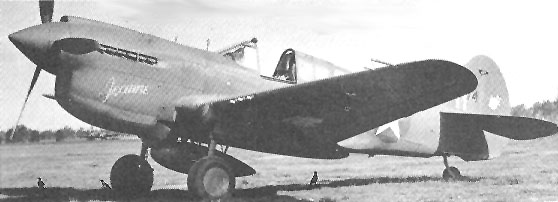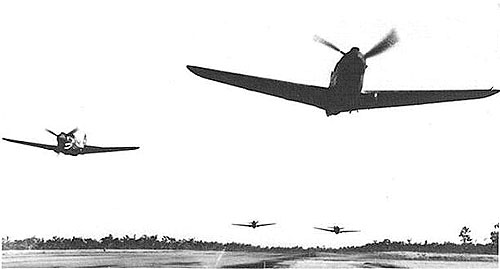
Try Amazon Audible Plus



Initially, each squadron received six planes. A PT-13 Ryan Basic Trainer, a PT-17 Stearman trainer, three worn out Seversky P-35’s (designated as an Advanced Trainer) and a single Curtiss P-40C. Between May and December, 1941, the 49th gradually matured but were still saddled with the obsolete Seversky fighters. After the Japanese attack on Pearl Harbor, training was noticeably stepped up and the 49th was utilized to fly anti-submarine patrols along the Florida coast in their ancient P-35 fighters. On January 4, 1942, the group was moved to San Francisco in preparation for deployment to the Pacific theater. The Group set sail on January 12, destination: Australia.
Having arrived in Melbourne on the 26th of January, the group was moved north to training bases where each squadron received 25 P-40E Warhawks. Still, the squadrons were less than fully trained with most pilots never having flown anything more advanced than the P-35. Training accidents were common. While none of the group’s fledgling aviators were killed, over two dozen wrecks occurred in the first 14 days of flying the P-40’s. The planes and pilots were repaired, and gradually, they mastered their new fighters.
The first squadron declared "combat ready" was the 7th, soon to be known as the Screamin’ Demons, they were transferred to Horn Island for combat duty on the 4th of March, 1942. The squadron’s first action was not long in coming.
March 14th saw the 7th FS scrambled to intercept a large formation of Japanese G4M "Betty" bombers, heavily escorted by Zero type fighters. Getting airborne quickly, 9 Warhawks climbed out, searching for the enemy. When Squadron Commander Morrissey gave the order to "charge guns", he found out to his dismay, that his own gun switch was inoperable. Handing the squadron over to Flt. Ldr. Reddington, he raced back down to Horn Island to get his gun switch repaired. RAAF ground crews got the problem fixed and one half hour after he discovered the gun fault, Morrissey was roaring back up to join his now circling squadron. Upon assuming lead again, it was quickly apparent that the squadron was in disorder. Shortly thereafter, Reddington announced that his guns as well, were dead. Morrissey sent him back to base. As he surveyed his strung out squadron Morrissey noticed that another P-40 was missing. But, it was too late to worry about that now.
By now, radio reports of bombs falling on their airfield imparted a sense of urgency upon Morrissey, who ordered a maximum power climb. Meanwhile the Japanese bombers, having completed their bomb run had begun a shallow dive to gain airspeed, while tightening their formation, expecting to be attacked on the return leg of their flight to Rabaul. They were soon set upon by a lone P-40. This was Morrissey’s missing P-40. Lt. Martin, uncertain if his C.O. would return in time, took out after the bombers alone. Unseen by the Zero escorts, Martin closed on the bombers and began firing at extreme range. Seeing his tracers missing, he bored in closer and fired off all of his ammunition. Convincing himself that one Betty was a goner, Martin rolled into a split-S and hauled out for Horn Island at maximum speed.
Morrissey spotted Martin as he was closing on the bomber formation, but thought Martin was one of the escort fighters. As the 8 Warhawks eased in behind the Japanese bombers, six Zeros were seen to be closing in on the bombers on their left. Morrissey took 4 P-40’s and slid in behind the Zeros, who were apparently fixated upon Martin as he sped away. Morrissey opened fire at about 600 feet behind the nearest Zero. The fighter exploded in flame and fell out of formation. The 5 remaining Zeros broke every which way. The superior turning ability of the Zero became obvious to 2 of the P-40 pilots, who, foolishly trying to out-turn them, had their planes peppered with rifle caliber bullets. Both dove for the deck and raced for home. Meanwhile, 2nd Lt. House managed to shoot up a Zero, which, trailing smoke, hauled around in a punishing turn, which House somehow matched. Upon trying to fire his guns, House discovered that the extreme G loading had jammed the ammo belts. Just then, House caught a glimpse of yet another Zero turning onto Morrissey’s tail. Without a second thought for jammed guns, House dove down on the Japanese fighter, intentionally smashing his right wing tip into the cockpit of the zero, killing the pilot instantly and shearing nearly 3 feet off the P-40’s right wing. As House fought to retain control of his battered Warhawk, the Zero spun into the sea below. During the same time span, two other P-40’s had shot up another Zero, and in turn were both hit themselves. Once again the superior dive speed of the Curtiss fighter enabled them to escape to safety. One by one the pilots of the 7th disengaged by diving away. Eventually, all but one made it back safely to Horn Island. Second Lt. House had to make a nerve wracking high speed flaps up landing, and pulled it off without incident.
Back on the ground, Morrissey gathered all his pilots together for a debriefing. Martin received a chewing out for breaking formation, but still earned great respect for his courage. Later, the RAAF reported the wreckage of a G4M was found in the sea and Martin received credit for the kill. Five kills were claimed by the 7th, but in reality, two of the Zeros were only damaged and nursed home. The Japanese were only missing 2 fighters. Remarkably, the Zero pilots claimed and received credit for 8 P-40’s destroyed. Yet, they really hadn’t shot down any. The missing pilot, having developed a serious oil leak, wisely disengaged from the air battle and promptly got himself lost. Running out of fuel, he then bailed out and swam to an island, where the local natives looked after him and brought him to a missionary who reported his survival to the RAAF.

